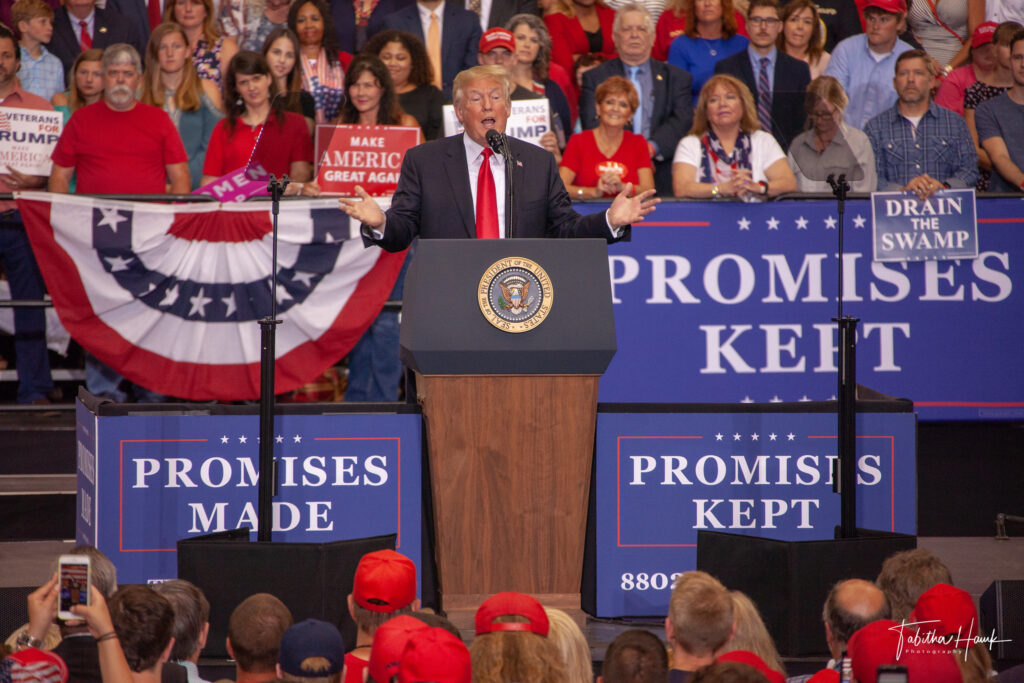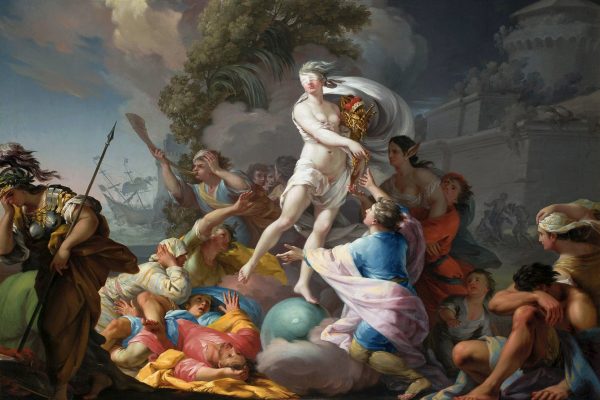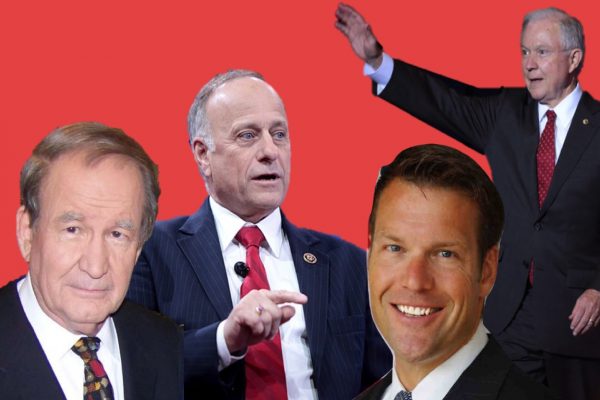“I can’t imagine him doing anything that’s not good for the country.” In an interview given on New Year’s Day this year, Jerry Falwell, Jr.—the son of the reverend, and now president of the evangelical school he founded, Liberty University—crystallized better than anyone the unswerving allegiance of Donald Trump’s core supporters. “I know anything he does, it may not be ideologically ‘conservative,’ but it’s going to be what’s best for this country,” Falwell said, in a striking display of cultish loyalty and departure from principled conservatism. For three years now many of us have been shaking our heads at the bizarre fact that Pat Robertson’s and Rev. Falwell’s Moral Majority of the 1980s has found its secular champion in a reality television star and accused sexual abuser.
While unusually low, Trump’s approval rating has never moved outside 35–45 percent. That variation is less than half that of Obama and JFK.
As we gear up for the 2020 election, the challenge to our understanding is no longer the unexpected turnout for Trump in 2016, but the remarkable persistence, force, and stability of Trumpism—the “anything he does” logic at work in Falwell’s remarks, which grants him carte blanche. The phenomenon has clarified itself: its base is stable, and its people have become the activist core of the Republican Party. Trump wins support not despite his transgressions but because of them. He is cheered as he flouts the Constitution, ignores longstanding customs and expectations, and violates political norms, morality, even good manners. Whatever critics find most troubling about Trump only further endears him to his supporters.
Gallup polls provide one indication of the intensity and devotion of the cult of Donald Trump—the remarkable stability of his support compared with every president back to Harry Truman. While unusually low, his approval rating has never moved outside 35–45 percent, with its highest spike last week. That variation is less than half the variation over the presidencies of Barack Obama and John F. Kennedy, those with the next most stable approval ratings. Trump knows the unusual intensity and loyalty of his base; Falwell’s “anything he does” is only the most recent confirmation of it. “I could stand in the middle of Fifth Avenue and shoot somebody and I wouldn’t lose voters,” he famously declared in January 2016.
Trump wins support not despite his transgressions but because of them.
Indeed, there is little reason to think anything that has transpired in the last three years will have fazed them, either. Nothing so far has seriously dented his support, including from Republican politicians, who have indeed only become more slavish. His approval rating briefly dropped three points after being defeated by Nancy Pelosi over his government shutdown to get funding for his wall, but he bounced back immediately. Defeat seems as useful to Trump as victory: after all, “they” refused to fund the wall. Even the shocking revelations about children being separated from their families at the border, or incarcerated in inhumane conditions, caused only a slight drop in support: after all, “they” are invading our country. (Don’t try to come to our country and you won’t be put in jail, they say.) The same is true of more recent behavior that most of the country regards as outrageous, such as tweeting racist attacks on minority congresswomen, and facilitating chants of “send her back” at his rallies: after all, “they” are colored and foreign and radical.
To understand the stability of this support, we must free ourselves from the prevailing fixation on Trump himself as the explanation for Trumpism. True, he has a cunning charisma; using very ordinary bearing and diction, he makes repeated chest-thumping references to being very rich, conveys a sense of his own genius, and relishes a near-total freedom to say and do anything. But the reason these tactics succeed is that they resonate with his base. “He tells it like it is” is still a common refrain among his supporters, meaning “how we really feel” behind the veil of political correctness. And so, unwaveringly, they devour each outrageous statement and eagerly anticipate the next.
Trump’s secret to success is that he expresses their values, angers, and evasions, their deep sense of alienation and grievance—cultural and social far more than economic. If he wins in 2020 it will be no fluke, as many concluded about 2016, but because a critical number of Americans have embraced that message. As campaign season takes off, we must not delude ourselves about exactly what Trumpism means.
Many theories have been propounded over the last three years about Trumpism’s defining features. One mistaken yet abiding explanation emerged in the immediate aftermath of the 2016 election, pointing to the economic resentment of the white working class. But this analysis turned on a distorted (and condescending) definition: it counted anyone without a college degree as working class. As Kim Moody pointed out, this embraces nearly 70 percent of white adults in the United States; among them are about 15 million white small business owners and their spouses, with an average income of over $112,000. As the historian Mike Davis put it, pundits made far too much of what he called a “modest and localized defection.” A relatively small and not unprecedented shift in the union vote did contribute to Trump’s paper-thin victory, but it was nowhere near a white working-class landslide.
Trump’s secret to success is that he expresses his base’s deep sense of alienation and grievance—cultural and social far more than economic.
The real white landslide lay elsewhere. Of those white voters who answered yes to “white born-again or evangelical Christian?” on exit polls, 80 percent voted for Trump. (Indeed, an underreported fact about the 2016 election is that aside from these evangelicals, Hillary Clinton trailed Trump among white voters by only 3 percentage points.) This figure was even higher than the 79 percent that had voted for Romney against Obama in 2012 and for fellow born-again Christian George W. Bush over Kerry in 2004. Turning out on election day at impressively higher rates than their share of the population (26 percent of all votes, versus 17 percent of the population), they provided Trump with just under half (44 percent) of his total votes. They are still with Trump today, and they will be with him in 2020.
It is tempting to take the exit-poll statistic about white evangelicals with a grain of salt. After all, answering “yes” to a pollster could well be more aspirational than principled, reflecting a desire to think of oneself as part of a certain group more than a commitment to particular religious beliefs and practices. But it still means something to identify with the intense and decentralized Christianity that has displaced the shrinking mainline denominations since the mid-1970s. People who identify as white born-again or evangelical Christians are not just like everyone else. A survey taken before the 2016 election is telling. A majority of whites (56 percent) said that American culture and way of life has mostly changed for the worse since the 1950s. Compare that to a large majority (over 60 percent) of African Americans who believed it had changed for the better. Among the whites, evangelical Protestants were the most dissatisfied of all, 74 percent of them agreeing that things have gotten worse. Another study gives a major reason why: a majority of whites believe that it is whites who are being discriminated against in American society today. Whatever other reasons evangelical Christians may have for gloom—abortion, homosexuality, pornography, immigration—more of them (57 percent) say that there is discrimination against Christians in the United States than acknowledge discrimination against Muslims (44 percent)!
The real landslide in the 2016 election lay among voters who identify as white evangelical Christians.
Evangelicalism has thus become as much a political as a religious identity. We cannot talk about this component of Trumpism without stressing that it is a response to a perceived crisis. In his book Family Values and the Rise of the Christian Right (2015), Seth Dowland traces the melding of conservative horror about the social, political, and lifestyle transformations of the 1960s with the drive among evangelical Christians to promote a racially coded and reactionary social vision of a patriarchal male-breadwinner family. The evangelical energy of the last generation, Dowland shows, was fueled by a conservative response among whites to the upheavals taking place around them, from the rise of wide acceptance of homosexuality and the growth of feminism to the attack on racial segregation and the emergence of more racially diverse communities. According to Dowland, evangelical belief and practice has been inseparable from the history and practices of American racism. “What most distinguishes white American evangelicals from other Christians, other religious groups, and nonbelievers,” Dowland wrote last year in Christian Century in an essay on the politics of whiteness, “is not theology but politics.”
Dowland’s analysis helps to explain the Falwellian allegiance of Trump’s white evangelical supporters. He alerts us to the fact that religious belonging is not necessarily the source of other elements of one’s identity. It is not that one votes or acts in such-and-such a way primarily or simply because of prior religious beliefs. Identity formation is instead an intersectional and dynamic feedback process; one’s class, race, gender, community membership, geographical place, and religious affiliation, among countless other qualities, interact in complex, overlapping, and mutually determining ways. Consider the fact that in the two decades leading up to 1993, membership in white evangelical churches ballooned from 18 to 30 percent of Americans. Was this change driven solely or simply by religious reasons, or was it a response by otherwise conservative souls to the upheavals of the times—to new demands, to new fears and threats? Instead of seeing religion solely as a source of other aspects of one’s identity, it is also fruitful to consider it as a product.
Evangelicalism has become as much a political as a religious identity, fueled by a conservative response among whites to a perceived crisis of dominance.
If it was fear of social change that helped drive the expansion of evangelical belonging since midcentury, it has taken on an indelible demographic reality in the years since. Amid the growth of multicultural and secular America, white Christians have been experiencing shrinking numbers and a perception of shrinking importance. This is the central theme of Robert P. Jones’s The End of White Christian America (2016), which gives an extended analysis of the historical displacement of white Christians, and especially those considering themselves evangelicals. After replacing mainline churches as the religious center of white Christian America in the late twentieth century, and while wielding considerable power in the Republican Party, evangelical Christian churches—most notably the Southern Baptist Convention—are now facing decline. The End of White Christian America unravels the slow, steady experience of their displacement from the center of a once-Christian country, and the growing awareness that “America’s religious and cultural landscape is being fundamentally altered.”
These demographic changes are both a source of alarm (for the communities affected) and a potential reason for optimism (for opponents of Trumpism). Not only is the number of white evangelicals continuing to decline, but their children are increasingly eschewing the identity. Churchgoing has seen a steep falling off among those aged 18 to 29. On the one hand, “nones”—those professing no religion—have risen steeply compared with any time in the past, and now are approaching 40 percent of the younger generation. On the other hand, while white evangelical Protestants now comprise perhaps a sixth of the U.S. population, they make up only 8 percent of 18 to 29 year-olds, the same portion of that age group as white mainline Protestants. The evangelical takeover of Protestantism is thus fading in the next generation. Trump exploited this anxiety. “This is our last chance to save our country and reclaim it for we the people,” he told his supporters before the 2016 election. “This is it.”
The political scientist Diana Mutz explored all these issues in her study of the 2016 election, published in the Proceedings of the National Academy of Sciences last year. Her conclusion is neatly summed up in her title, “Status threat, not economic hardship, explains the 2016 presidential vote.” As she explains:
Evidence points overwhelmingly to perceived status threat among high-status groups as the key motivation underlying Trump support. White Americans’ declining numerical dominance in the United States together with the rising status of African Americans and American insecurity about whether the United States is still the dominant global economic superpower combined to prompt a classic defensive reaction among members of dominant groups.
Mutz’s quantitative analysis has not gone uncriticized, but the larger thrust of her argument seems undeniable. An African American man becomes elected, and the battle cry becomes “Take America back!” Hispanic immigrants become more visible, and the battle cry becomes “Build the wall!” A Muslim-American congresswoman criticizes the president, and the battle cry becomes “Send her back!” As Mutz explains, “It is not racism of the kind suggesting that whites view minorities as morally or intellectually inferior, but rather, one that regards minorities as sufficiently powerful to be a threat to the status quo.”
A key motivation of Trumpism is the refusal of whites to accept minority-hood. Grievance fuels Trump’s base, giving voice to their resentment of a world overrun by Others.
Mutz emphasizes how deep the experience of displacement runs. Evidence of African Americans’ racial progress threatens them, causing them to experience “lower levels of self-worth” relative to blacks. Accordingly, one defense mechanism entails perceiving “greater antiwhite bias.” Or should we say inventing antiwhite bias, inventing a serious threat from Mexican immigrants and Muslims, and vastly exaggerating the threat from foreign terrorists? White Christians, for all of U.S. history the dominant population, now see Others almost everywhere they look. Most of the athletes they cheer are Others, and much of the music they enjoy comes from Others. Their doctors and nurses are increasingly Others. And the word is out: by 2042 or thereabouts, the U.S. Census predicts that whites will be a minority. In the words of Albert Mohler, president of the Southern Baptist Theological Seminary, “It’s going to be a chastening, humbling moment for American Christians to realize that we’re going to be in the position across the country of speaking as a minority.”
Some have argued that Trump was catapulted to electoral victory thanks to endorsements from evangelical leaders such as Jerry Falwell, Jr. In truth, the base took shape earlier, and was moved by different concerns than the leadership (even as Falwell now sounds more and more like the base). As Myriam Renaud points out, in their relative indifference to the “amped up” issues of abortion and appointments to the Supreme Court during 2016, there was indeed an “opinion gap between the people in the pews and their clergy.” In contrast to their pastors, a huge percentage of the rank and file showed greatest concern about terrorism, the economy, immigration, foreign policy, and gun policy—precisely the issues turned up by Mutz’s research.
After a generation of listening to apocalyptic, fearful sermons about America going to hell, Trump’s evangelical supporters have had plenty of training in thinking this way.
A key motivation of Trumpism, in short, is the refusal of whites to accept minority-hood. After a generation of listening to apocalyptic, fearful sermons about America going to hell, Trump’s evangelical supporters have had plenty of training in thinking this way. Their leaders have for years been preparing them to deny the present and to fear modern life as an existential threat. In Children at Risk (1990), one of the founding documents of the culture wars, James Dobson described today’s clash of values: “Two sides with vastly differing and incompatible worldviews are locked in bitter conflict that permeates every level of society. . . And someday soon, I believe, a winner will emerge and the loser will fade from memory.” This long history reminds us that Trumpism is a story of chickens coming home to roost. Over the last few generations, bitter resistance to modernity, equality, and democracy—along with hostility for contemporary “elites” (but never the major corporations and their owners)—has seeped down from the original sin of slavery, culminating in the powerful, reactionary, remarkably stable backlash of Trumpism. Dobson is right: we are in a war.
As 2020 approaches, this unshakeable relationship between Trump and his base looms. The sheer stability of Trump’s hold on power and the cult-like allegiance of his people is the strongest reason to fear another four years of Trumpism. After all, Trump controls the agenda, as he brilliantly demonstrates day in and day out. No one can say whether investigations and the prospect of impeachment will reverse this trend or only further confirm it. It is sobering to note that Richard Nixon’s support had to drop to 24 percent before Republicans abandoned ship, while Trump’s climbed to the mid-40s after his “Send her home!” attack on Ilhan Omar. After all, grievance fuels Trump’s base, giving voice to and yet sublimating their own sense of resentment against a world overrun by Others.
Richard Nixon’s support had to drop to 24 percent before Republicans abandoned ship. Trump’s climbed to the mid-40s after his attack on Ilhan Omar.
Trump often uses the term “movement” to describe this force he has created, this community that his supporters belong to. And no doubt there are many movement aspects to Trumpism: the T-shirts and caps, the sense of belonging to a common cause, the camaraderie the members of his base feel for each other as they wait for the rallies to begin, the radio and television personalities they enjoy, the fact that they often drive hundreds of miles to get together—a sign they are as much about being together for their shared cause as listening to Trump and loving him. And they have a strong collective experiences of cheering in adoring appreciation and booing in resentful anger.
But it is not really a movement in the sense of taking collective action. When Trump told the Republican convention in 2016 that America was beset with ills, he avowed, “I alone can fix it,” and the crowd cheered. This “movement” asks his supporters to do nothing but be there, to support and defend him to their friends and family. A striking contrast came with the rally in Iowa where Bernie Sanders announced his 2020 candidacy. When the crowd at one point chanted his name, Sanders departed from his prepared text and said: “It ain’t Bernie, it’s you. It’s not me, it is us.” He explained: “The truth is that the powers that be, they are so powerful, they have so much money, that no one person, not the best president in the world, can take them on alone. The only way we transform America is when millions of people together stand up and fight back.” This is the opposite of Trumpism: organizing a movement of activists agitating from below to bring about significant change.
Whether Trump’s loyal coalition of aggrieved whites will win once again depends on just how successfully those activists can agitate in the coming months.
This essay is adapted from the author’s earlier essay “Revolt Against Democratic Modernity: The Unholy Marriage of Trump and his Base,” published in The Journal of the Helen Suzman Foundation in June.








